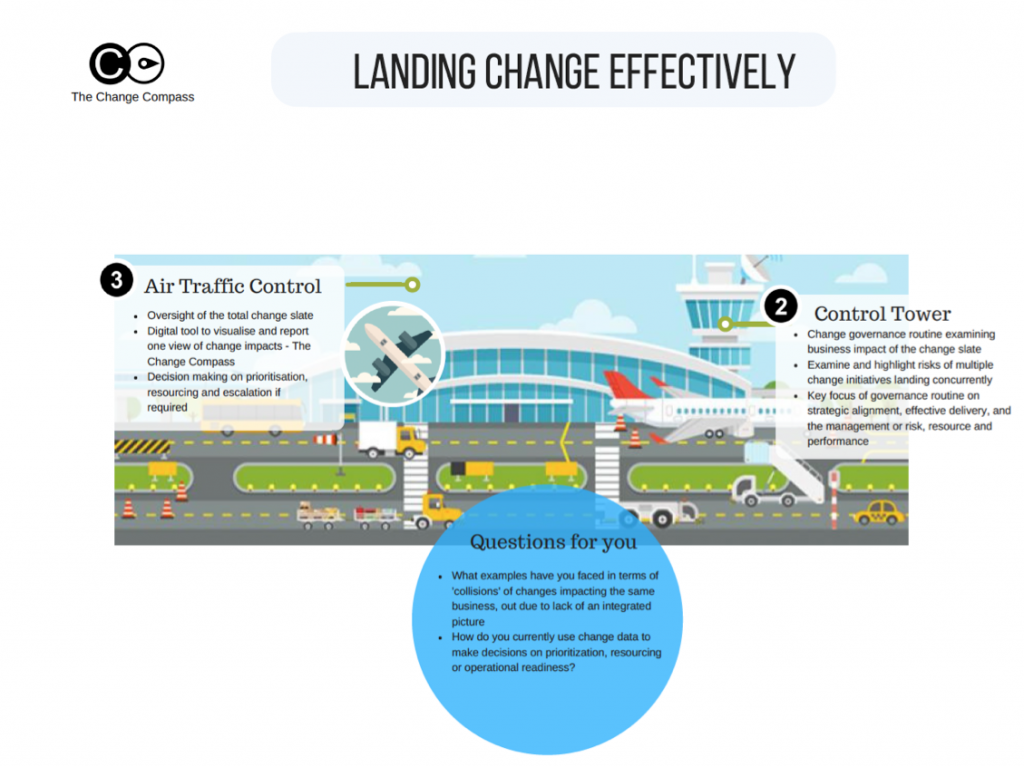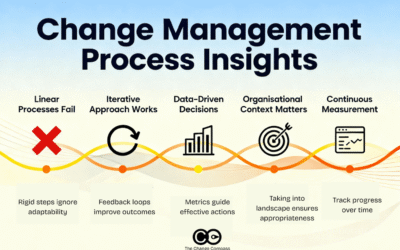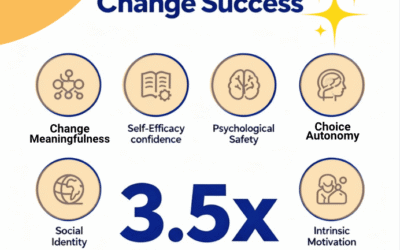Adapting to complex organizational change has always been a formidable challenge for organizations, but the complexities of today’s business landscape have taken this challenge to a new level. With the relentless march of various types of organizational change such as technological advancements, new products, the dynamic shifts in market dynamics, and the constant evolution of the workforce, organizations find themselves in a perpetual state of organisational transformation. Effectively navigating these changes within an intricate and multifaceted environment is no longer a choice but a necessity. In this era of constant flux, mastering the art of change implementation within complex change contexts has become a critical skill for organizations seeking not only survival but also prosperity.
This article is dedicated to unraveling the intricacies of change management within such complex settings, providing a comprehensive exploration of the effective framework of strategies and considerations that can illuminate each step of the model for successful change implementation.
Understanding the Complex Environment
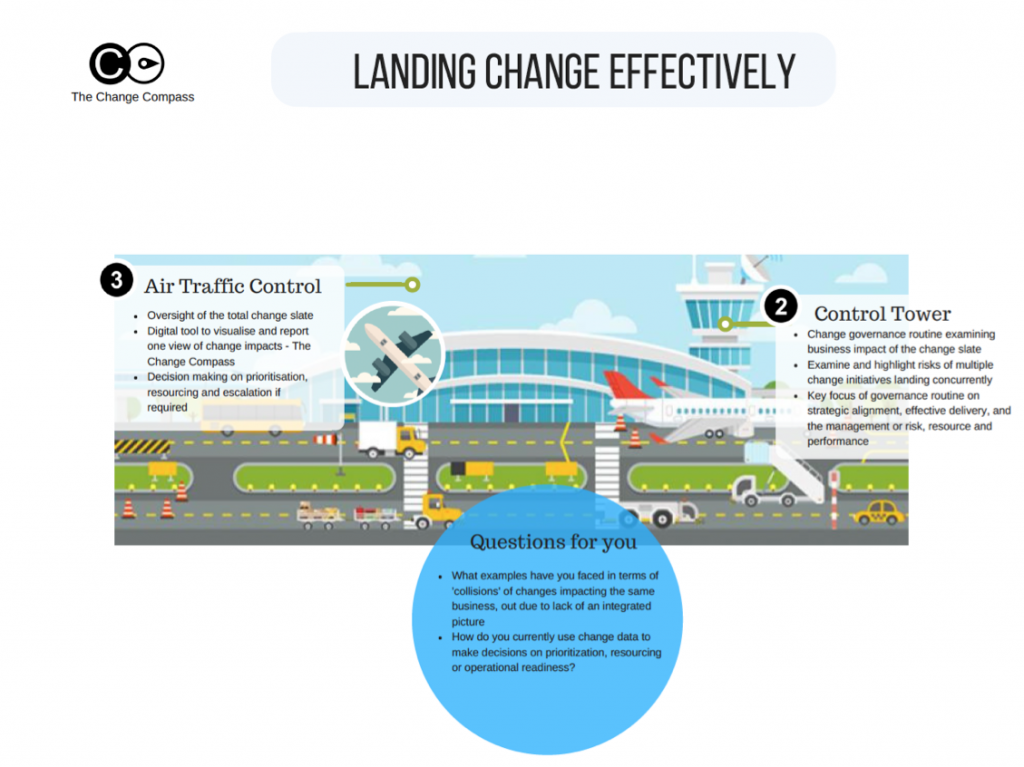
Complex environments, as depicted by the infographic, resemble a bustling traffic control center overseeing a multitude of ongoing changes. These environments typically feature intricate organizational structures with various departments, multiple stakeholder interests, regulatory requirements, and external factors like economic conditions, global trends, and competition—all converging and coexisting like different lanes of traffic.
Just as a traffic control center needs a comprehensive view to manage traffic effectively, organizations must also have a holistic understanding of their unique complexities to facilitate change management to avoid change fatigue. The infographic highlights the importance of having a powerful tool like, “The Change Compass,” to visualize and report one view of change impacts, much like the control tower in our analogy. “The Change Compass” aids in decision-making regarding prioritization, resourcing, and escalations when required, ensuring smoother change implementation.
Much like a control tower’s routine examination of air traffic, change governance routines within complex environments need to scrutinize the business impact of the change slate. They should examine and highlight potential risks when multiple change initiatives land concurrently. The key focus of governance routines should revolve around maintaining strategic alignment, ensuring effective delivery, and managing risks, resources, and performance effectively within the complex change model.
In the context of the infographic and your real-world experience, it’s important to consider situations where changes collide due to a lack of an integrated picture. Understanding these scenarios and their consequences can further emphasize the importance of a comprehensive view of the magnitude of change, akin to what “The Change Compass” offers to organizational transformation.
Additionally, the infographic raises questions about the utilization of change data for a structured approach in decision-making. As you review these questions, it’s essential to reflect on your organization’s practices and how it currently employs change data to prioritize initiatives, allocate resources, and assess operational readiness.
By aligning these insights from the infographic with your practical experiences, you can gain a deeper appreciation of the nuances and challenges within complex environments and the strategies required for becoming a successful change leader in effective change management.
Key Strategies for Effective Change Implementation
Clear Vision and Communication: Imagine a ship embarking on a complex voyage. In this analogy, a well-articulated vision serves as the North Star, guiding the crew toward their desired destination. A successful change initiative begins with a clear and compelling vision, offering a picture of the future state. Within complex environments, the importance of this vision is magnified. It’s vital that this vision is not just communicated but ingrained, clear, and consistent across the organization to ensure clear goals are set. Complex environments often require tailored communication strategies, akin to setting multiple navigation markers, to reach diverse stakeholder groups effectively. From employees to executives, everyone on the ship should have a deep understanding of the change’s purpose and the benefits it will bring.
Stakeholder Engagement: Complex environments can be likened to a bustling marketplace where diverse customers with unique tastes gather. Managing change within such settings requires recognizing and respecting these differences, particularly the different interests of stakeholders. Just as merchants engage in open dialogue with customers to understand their preferences, organizations must engage key stakeholders in meaningful ways. This includes involving them in the decision-making process and addressing their interests and concerns. By aligning the organization’s objectives with the diverse needs of these stakeholders, you ensure a smoother journey toward successful change implementation.
Adaptability: Picture change within complex environments as a voyage with unpredictable weather. The ability to adapt is the organization’s agility in navigating through choppy waters. Change within these environments is rarely a straightforward path; it often demands adaptability and the willingness to adjust course based on emerging challenges or unforeseen opportunities. Like skilled sailors, leaders and change agents must be open to feedback, agile in their decision-making, and ready to adjust the change strategy to accommodate unexpected developments. Flexibility is the key when facing the uncertainties inherent in complex settings.
Change Champions: Think of change champions as the seasoned navigators of the ship. These individuals are passionate advocates for change, influential within the organization, and adept at mentoring and supporting others in adopting new ways of working as part of the change. Empowering these champions is akin to putting experienced navigators at the helm; it significantly accelerates the change process and bolsters its chances of success.
Comprehensive Risk Management: Complex environments can be compared to a terrain filled with potential obstacles and surprises. To navigate these challenges successfully, organizations must conduct a thorough risk assessment, much like charting the unknown waters ahead. It is essential to develop robust risk mitigation plans that identify potential roadblocks or setbacks in advance and have strategies in place to address them. Risk management should be an ongoing process throughout the change journey, just as a vigilant captain keeps a watchful eye on the horizon.
Data-Driven Decision-Making: Envision data as a compass that guides the ship through uncharted waters. Leveraging data analytics and monitoring tools can provide valuable insights into the impact of the change. Like a captain relying on navigation instruments, organizations can make informed decisions by continuously monitoring progress and adjusting strategies based on data-driven insights. This ensures that the ship stays on the right course and is ready to make course corrections as needed.
Continuous Learning and Improvement: Consider change implementation as a perpetual voyage of discovery. Organizations should foster a culture of continuous learning and improvement, much like a ship’s log recording its journey. Lessons learned from previous change initiatives should be used to refine future strategies and enhance the organization’s skill acquisition and change management capabilities. A feedback loop, encouraging crew members to share their experiences and insights, can be instrumental in this process, much like sailors sharing their knowledge to improve the voyage.
Resource Allocation: Resource allocation can be compared to provisioning the ship for a long journey. Efficient allocation of necessary resources is critical, especially in resource-constrained complex environments. Organizations must prioritize resource allocation where it is most needed, focusing on areas that will have the greatest impact on the success of the change initiative. This may involve reallocating human resources, budget, or other assets to support the change effort. Resource allocation decisions should be informed by a clear understanding of the change’s objectives and the unique challenges posed by the complex environment, much like carefully planning and managing supplies for the voyage.
These strategies form the compass and toolkit for organizations seeking to navigate the complex seas of change, while considering their organizational culture. Just as a skilled captain combines experience, navigation tools, and a committed crew of team members to chart a successful course, organizations can achieve effective change implementation by integrating these strategies into their change management process.
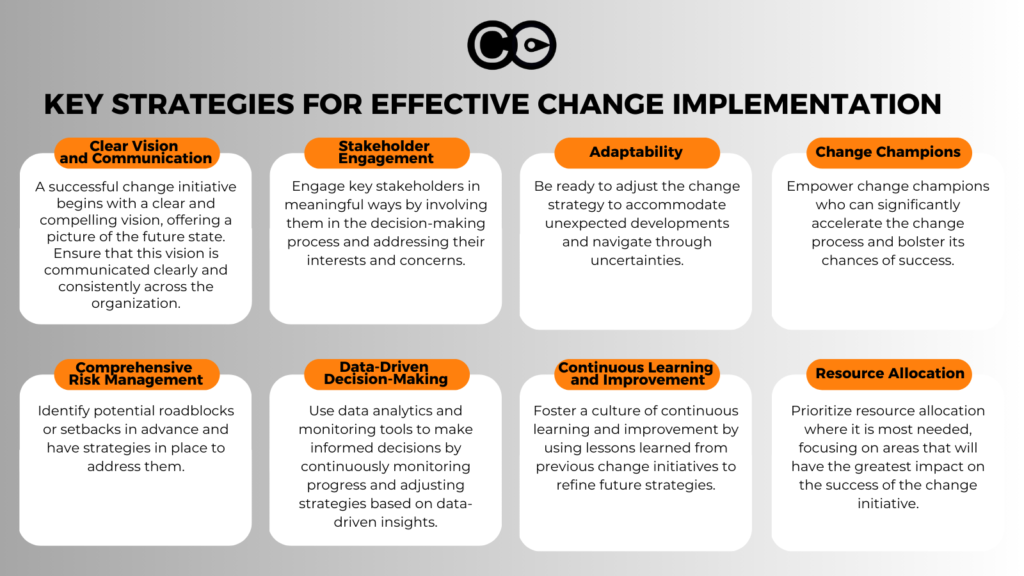
Effectively landing change within a complex environment is a multifaceted and challenging process, especially when there are high levels of uncertainty. However, it is not without its rewards. With a clear vision, robust communication, stakeholder engagement, adaptability, data-driven decision-making, a commitment to continuous improvement, and a strategic approach to resource allocation, organizations can successfully navigate such complex changes in the complexities of change implementation.
In a world where change is the new constant, mastering the art of change by acquiring new skills within complex environments is not only a valuable skill but a competitive advantage. By doing so, organizations can emerge stronger, more agile, and better prepared to face the dynamic challenges of today’s business world.
The ability to implement change within complex environments is a key differentiator that sets organizations on a path to resilience and long-term success. To take the first step in mastering the art of change within complexity, we invite you to book a weekly demo with “The Change Compass.” Discover how our innovative digital tool can be your trusted guide in navigating change within complex environments. Embrace the challenges, and unlock the opportunities that lie ahead in the ever-evolving landscape of business transformation.
Landing change effectively within a complex environment
Adapting to change has always been a formidable challenge for organizations, but the complexities of today’s business landscape have taken this challenge to a new level. With the relentless march of technological advancements, the dynamic shifts in market dynamics, and the constant evolution of the workforce, organizations find themselves in a perpetual state of transformation. Effectively navigating these changes within an intricate and multifaceted environment is no longer a choice but a necessity. In this era of constant flux, mastering the art of change implementation within complex contexts has become a critical skill for organizations seeking not only survival but also prosperity.
This article is dedicated to unraveling the intricacies of change management within such complex settings, providing a comprehensive exploration of the strategies and considerations that can illuminate the path to successful change implementation.
Understanding the Complex Environment
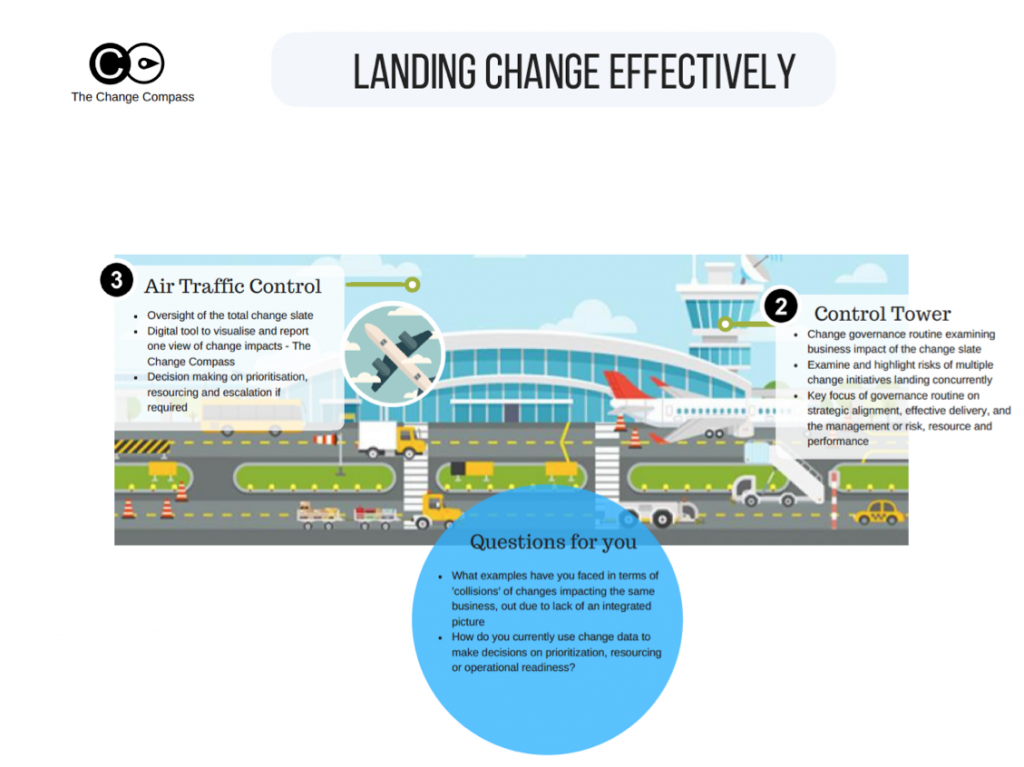
Complex environments, as depicted by the infographic, resemble a bustling traffic control center overseeing a multitude of ongoing changes. These environments typically feature intricate organizational structures with various departments, multiple stakeholder interests, regulatory requirements, and external factors like economic conditions, global trends, and competition—all converging and coexisting like different lanes of traffic.
Just as a traffic control center needs a comprehensive view to manage traffic effectively, organizations must also have a holistic understanding of their unique complexities to facilitate change management. The infographic highlights the importance of having a tool like, “The Change Compass,” to visualize and report one view of change impacts, much like the control tower in our analogy. “The Change Compass” aids in decision-making regarding prioritization, resourcing, and escalations when required, ensuring smoother change implementation.
Much like a control tower’s routine examination of air traffic, change governance routines within complex environments need to scrutinize the business impact of the change slate. They should examine and highlight potential risks when multiple change initiatives land concurrently. The key focus of governance routines should revolve around maintaining strategic alignment, ensuring effective delivery, and managing risks, resources, and performance effectively.
In the context of the infographic and your real-world experience, it’s important to consider situations where changes collide due to a lack of an integrated picture. Understanding these scenarios and their consequences can further emphasize the importance of a comprehensive view, akin to what “The Change Compass” offers.
Additionally, the infographic raises questions about the utilization of change data for decision-making. As you review these questions, it’s essential to reflect on your organization’s practices and how it currently employs change data to prioritize initiatives, allocate resources, and assess operational readiness.
By aligning these insights from the infographic with your practical experiences, you can gain a deeper appreciation of the nuances and challenges within complex environments and the strategies required for effective change management.
Key Strategies for Effective Change Implementation
Clear Vision and Communication: Imagine a ship embarking on a complex voyage. In this analogy, a well-articulated vision serves as the North Star, guiding the crew toward their desired destination. A successful change initiative begins with a clear and compelling overall vision, offering a picture of the future state and how it differs from the current state. Within complex environments, the importance of this vision is magnified. It’s vital that this vision is not just communicated but ingrained, clear, and consistent across the organization. Complex environments often require tailored communication strategies, akin to setting multiple navigation markers, to reach diverse stakeholder groups effectively. From employees to executives, everyone on the ship should have a deep understanding of the change’s purpose and the benefits it will bring.
Stakeholder Engagement: Complex environments can be likened to a bustling marketplace where diverse customers with unique tastes gather. Managing change within such settings requires recognizing and respecting these differences. Just as merchants engage in open dialogue with customers to understand their preferences, organizations must engage key stakeholders in meaningful ways. This includes involving them in the decision-making process and addressing their interests and concerns. By aligning the organization’s objectives with the diverse needs of these stakeholders, you ensure a smoother journey toward successful change implementation.
Adaptability: Picture change within complex environments as a voyage with unpredictable weather. The ability to adapt is the organization’s agility in navigating through choppy waters. Change within these environments is rarely a straightforward path; it often demands adaptability and the willingness to adjust course based on emerging challenges or unforeseen opportunities. Like skilled sailors, leaders and change agents must be open to feedback, agile in their decision-making, and ready to adjust the change strategy to accommodate unexpected developments. Flexibility is the key when facing the uncertainties inherent in complex settings.
Change Champions: Think of change champions as the seasoned navigators of the ship. These individuals are passionate advocates for change, influential within the organization, and adept at mentoring and supporting others in adopting new ways of working. Empowering these champions is akin to putting experienced navigators at the helm; it significantly accelerates the change process and bolsters its chances of success.
Comprehensive Risk Management: Complex environments can be compared to a terrain filled with potential obstacles and surprises. To navigate these challenges successfully, organizations must conduct a thorough risk assessment, much like charting the unknown waters ahead. It is essential to develop robust risk mitigation plans that identify potential roadblocks or setbacks in advance and have strategies in place to address them. Risk management should be an ongoing process throughout the change journey, just as a vigilant captain keeps a watchful eye on the horizon.
Data-Driven Decision-Making: Envision data as a compass that guides the ship through uncharted waters. Leveraging data analytics and monitoring tools can provide valuable insights into the impact of the change. Like a captain relying on navigation instruments, organizations can make informed decisions by continuously monitoring progress and adjusting strategies based on data-driven insights. This ensures that the ship stays on the right course and is ready to make course corrections as needed.
Continuous Learning and Improvement: Consider change implementation as a perpetual voyage of discovery. Organizations should foster a culture of continuous learning and improvement, much like a ship’s log recording its journey. Lessons learned from previous change initiatives should be used to refine future strategies and enhance the organization’s change management capabilities. A feedback loop, encouraging crew members to share their experiences and insights, can be instrumental in this process, much like sailors sharing their knowledge to improve the voyage.
Resource Allocation: Resource allocation can be compared to provisioning the ship for a long journey. Efficient allocation of resources is critical, especially in resource-constrained complex environments. Organizations must prioritize resource allocation where it is most needed, focusing on areas that will have the greatest impact on the success of the change initiative. This may involve reallocating human resources, budget, or other assets to support the change effort. Resource allocation decisions should be informed by a clear understanding of the change’s objectives and the unique challenges posed by the complex environment, much like carefully planning and managing supplies for the voyage.
These strategies form the compass and toolkit for organizations seeking to navigate the complex seas of change. Just as a skilled captain combines experience, navigation tools, and a committed crew to chart a successful course, organizations can achieve effective change implementation by integrating these strategies into their change management process.
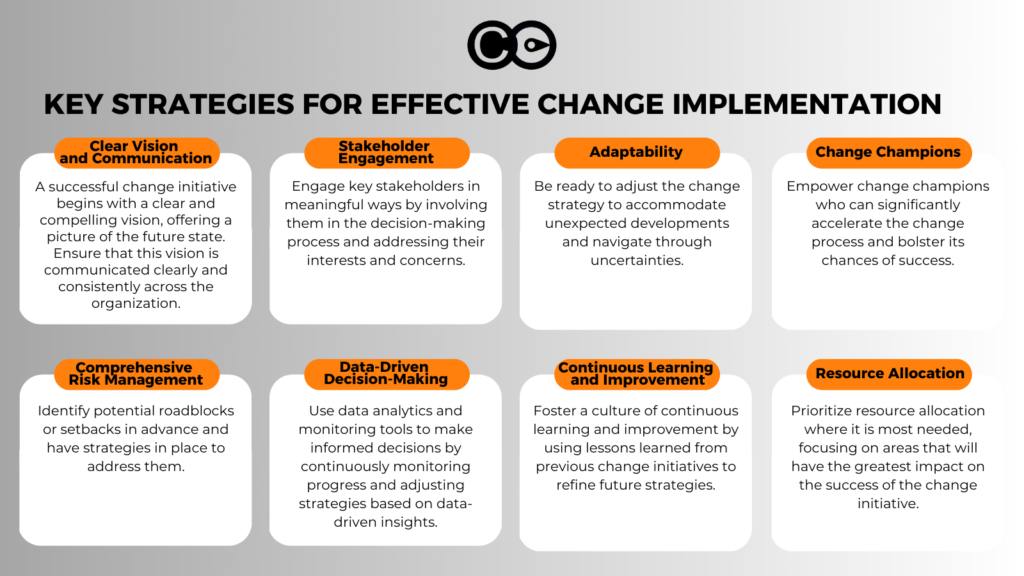
Effectively landing change within a complex environment is a multifaceted and challenging process. However, it is not without its rewards. With a clear vision, robust communication, stakeholder engagement, adaptability, data-driven decision-making, a commitment to continuous improvement, and the final element of a strategic approach to resource allocation, organizations can successfully navigate the complexities of change implementation.
In a world where change is the new constant, mastering the art of change within complex environments is not only a valuable skill but a competitive advantage. By doing so, organizations can emerge stronger, more agile, and better prepared to face the dynamic challenges of today’s business world.
The ability to implement change within complex environments is a key differentiator that sets organizations on a path to resilience and long-term success. To take the first step in your action plan, we invite you to book a weekly demo with “The Change Compass.” Discover how our innovative digital tool can be your trusted guide in navigating change within complex environments. Embrace the challenges, and unlock the opportunities that lie ahead in the ever-evolving landscape of business transformation.
